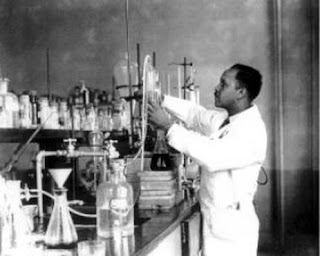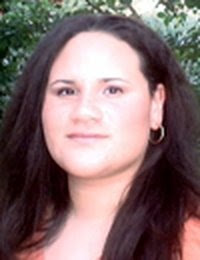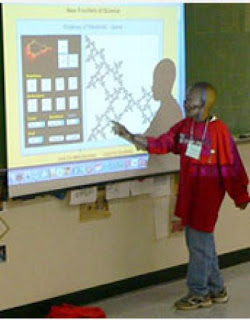HUNTSVILLE, Ala. – Lorna Graves Jackson, an engineer at NASA's Marshall Space Flight Center in Huntsville, Ala., and a native of Everett, Mass., has received a National Women of Color Technology Award for exceptional professional and community service.
Career Communication Group's Women of Color magazine and the IBM Corporation presented Jackson with its "Technology All-Stars" award, recognizing accomplished women of color who are advanced in their careers and have demonstrated excellence as leaders at work and in their communities.
Jackson leads several employees as branch chief of the Avionics Systems Integration Branch in the Systems Engineering and Integration Division of the Space Systems Department, part of the Marshall Center's Engineering Directorate mentoring other minorities in this role. The branch includes avionics lead systems engineers that integrate various launch vehicle avionics hardware and software systems that support the Constellation Program, a NASA initiative to create a new generation of spacecraft for human spaceflight, including the Ares I and Ares V launch vehicles.
 |
Jackson came to Marshall in 1986 as a lead engineer for in-house electrical power systems test beds for the Hubble Space Telescope mission. She took on additional responsibilities in 1990 when she joined the technical support team at the Chandra X-ray Observatory as Electrical Power System lead engineer and Electrical Design Integration lead. |
From 2001 to 2003, Jackson served in several roles with the Second Generation Reusable Launch Vehicle Space Launch Initiative Program, including avionics lead sub-system engineer for Space Launch Initiative Vehicle Integrated Performance Analysis activities and Integrated Vehicle Health Management requirements lead for Marshall's Systems Engineering and Integration Office. The Space Launch Initiative was designed to develop technologies and lead to the creation of a second generation reusable launch vehicle.
Jackson moved to Marshall's Orbital Space Plane Program Office in 2003, where she was co-lead of the Exploration System Mission Directorate Ground Infrastructure Integrated Discipline Team. She helped identify NASA facilities, facility systems and support equipment for manufacturing, testing and logistics activities to assess ground infrastructure capabilities, risk implications and development plans.
In 2005, she was named acting branch chief of the Design Integration Branch of the System Design and Analysis Division in the Spacecraft and Vehicle Systems Department. Jackson led more than 50 civil servants and contractors that supported systems engineering and integration for the Exploration Systems Mission Directorate Constellation, Shuttle External Tank and Expendable Launch Vehicle Programs. She became deputy branch chief in 2006.
Jackson was named branch chief of the Systems Management Branch of the Systems Engineering Division in the Spacecraft and Vehicle Systems Department in June 2007, where she led a team of more than 60 employees in configuration, data and risk management, and engineering planning to support complex launch vehicle systems. She began her current role as Avionics Systems Integration Branch chief in November 2007.
Jackson earned a bachelor's degree in electrical engineering from the Georgia Institute of Technology in Atlanta in 1982. She has earned numerous honors and awards during her career, including a NASA Exceptional Achievement Medal in 2000 for technical excellence and personal dedication on the Chandra X-ray Observatory Electrical Power System development.
Jackson received the "Technology All-Stars" award in November 2007 at the 12th annual National Women of Color Science, Technology, Engineering and Math Conference in Atlanta. The conference is for minority women in information technology, computer science, information science and digital arts.
Jackson and her husband, Kurt, have two children and live in Huntsville.
 | HUNTSVILLE, Ala. – Marceia Clark-Ingram, an engineer at NASA's Marshall Space Flight Center in Huntsville, Ala., and a native of Detroit, has received a National Women of Color Technology Award for exceptional professional service. |
Career Communication Group's Women of Color magazine and the IBM Corporation presented Clark-Ingram with its “Technology All-Stars” award, recognizing accomplished women of color who are advanced in their careers and have demonstrated excellence as leaders at work and in their communities. She was nominated for her “professional dedication and enthusiasm” on projects for the Materials and Processes Laboratory at the Marshall Center.
Clark-Ingram is a senior material and processes engineer and advanced materials science specialist in the Laboratory Lead Engineers Office of the Materials and Processes Laboratory, part of the Marshall Center’s Engineering Directorate. She also is the primary Materials and Processes Laboratory's technical lead for interfacing with Marshall’s Propulsion Systems Engineering and Integration Office and the Shuttle Environmental Assurance initiative. This initiative supports mission execution through the life cycle of the Space Shuttle Program by identifying materials that may become obsolete as result of environment, health and safety regulations and mitigating these risks through teamwork.
Clark-Ingram began her career at NASA in 1987 when she participated in NASA's Professional Internship Program, working in the Corrosion Branch of the Materials and Processes Laboratory as a chemical engineer. From 1988 to 1992, she served as an analytical chemist in the Analytical and Physical Chemistry Branch of the lab. In 1991, she performed project management duties for the NASA Operational Environment Team as an experimental manufacturing techniques engineer in the Process Engineering Division of the Materials and Processes Laboratory.
She joined the Materials Compatibility and Environmental Engineering Branch of the Materials and Processes Laboratory in 1992 as an aerospace materials engineer, where she supported the development of a NASA-wide program plan for responding to Environmental Protection Agency (EPA) Clean Air Act regulations and routinely presented NASA’s materials usage data to the EPA.
In 1995, she served as a structural materials engineer for the Materials and Processes Chemistry Group in the Materials and Processes Laboratory. She was a technical lead for the NASA, Environmental Protection Agency and Air Force Interagency Depainting Project, which tested technologies to be used as paint-stripping processes that did not adversely affect the environment.
Clark-Ingram was promoted to team lead in the chemistry group for the Materials Replacement Technology team in 2000. Her duties included technical oversight and program planning for the NASA Principal Center for the Review of Clean Air Act Regulations effort. This effort provided a proactive approach for the evaluation of potential impacts and risks to NASA’s programs due to usage restrictions of targeted materials. Additional responsibilities encompassed technical oversight for the testing operations at Marshall's Materials Combustion Research Facility and Materials Environment Test Complex.
During 2004, she was a test engineer for the Structural Strength Test Branch of the Engineering Directorate. She provided technical support for testing conducted on thermal protection systems at the Materials Environment Test Complex in support of the Space Shuttle Return to Flight effort.
Clark-Ingram earned a bachelor’s degree in chemical engineering from Tuskegee University in Tuskegee, Ala., in 1985, and a master's degree in 1995 in management sciences from the Florida Institute of Technology at Redstone Arsenal’s satellite facility.
She has earned numerous honors and awards during her career, including a NASA Blue Marble Award in 2005 for excellence in environmental and energy management demonstrated in support of NASA’s mission and an exceptional service medal for outstanding technical contributions to NASA programs in 2000.
Clark-Ingram received the "Technology All-Stars" award in November 2007 at the 12th annual National Women of Color Science, Technology, Engineering and Math Conference in Atlanta. The conference is for minority women in information technology, computer science, information science and digital arts.
Clark-Ingram and her husband, Neal, have two children and live in Madison, Ala.
 | HUNTSVILLE, Ala. – Tawnya Plummer Laughinghouse, an engineer at NASA's Marshall Space Flight Center in Huntsville, Ala., and a native of Huntsville, has received a National Women of Color Technology Award for exceptional professional and community service. |
Career Communication Group’s Women of Color magazine and the IBM Corporation presented Laughinghouse with its “Rising Star” award, recognizing young minority women who have excelled quickly in technology-driven professions.
Laughinghouse is a materials engineer in the Nonmetals Engineering Branch and provides ceramic and ablative material expertise in support of NASA projects, such as the small solid propellant motors associated with the Shuttle Solid Rocket Booster, the Ares First and Upper Stages and the Orion Launch Abort System.
She began her career at NASA in 1990 when she participated in NASA’s Summer High School Apprenticeship Research Program. From 1991 to 1996, she served as a NASA Women in Science and Engineering scholar, which provided her a full-tuition college scholarship and summer internships at the Marshall Center.
After graduating college in 1996, Laughinghouse was a process chemist at Daubert VCI Inc. in Cullman, Ala., and in 1999, she joined Aerovox Inc. of Huntsville as a product engineer. She returned to the Marshall Center in 2004 as a materials engineer.
Laughinghouse earned a bachelor’s degree in chemistry from Spelman College and a bachelor’s degree in chemical engineering from the Georgia Institute of Technology, both located in Atlanta, in 1996. In 2006, she received a master’s degree in management, with a concentration in management of technology, from the University of Alabama in Huntsville.
She has earned numerous honors and awards during her career, including selection into the 2008 NASA Foundations of Influence, Relationships, Success and Teamwork, or NASA FIRST, leadership development team. The program helps participants develop foundational leadership skills.
Laughinghouse received the Rising Star award in November 2007 at the 12th annual National Women of Color Science, Technology, Engineering and Math Conference in Atlanta. The conference supports and recognizes the accomplishments of minority women in information technology, computer science, information science and digital arts. Laughinghouse and her husband, Scott, have one daughter, and live in Huntsville.
Betty Humphery
Marshall Space Flight Center, Huntsville, Ala. 256-544-0034
betty.b.humphery@nasa.gov Web:
Marshall Diversity News Releases





































